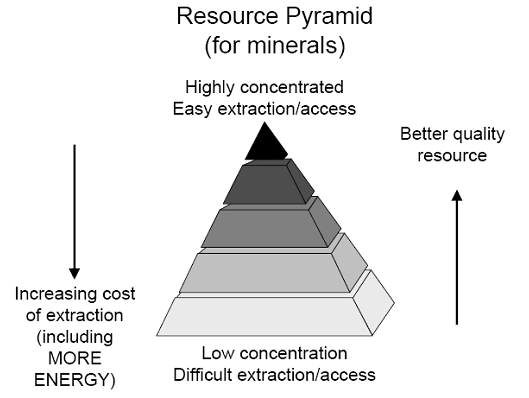Cornucopians - those who believe the Earth’s resources are boundless - have a clever mental trick to avoid acknowledging that the planet is finite. It is commonly called the “resource pyramid”.
The argument goes like this. When we first begin to extract a substance from a resource we exploit that resource in which the substance is most concentrated (and so easiest to purify) and/or most accessible.
An example of this would be digging large gold nuggets out of riverbanks in the Victorian goldfields in the 1850s or mining phosphate-rich guano on the Pacific island of Nauru by simply scooping it up and bagging it. However, as you probably know, the alluvial gold of Victoria and the guano on Nauru were both mined out many years ago.
Advertisement
You might think that this would lead to a severe shortage of these materials but this is where the resource pyramid works it magic. As these resources begin to become scarce their price rises. The higher price now makes it economically viable to extract the substance from a less accessible and/or less concentrated source. Amazingly, the total amount of the substance present in this lower-grade resource is greater than in the original, most concentrated resource. This pattern repeats. As the less concentrated resource begins to be mined out the price of the substance rises ever higher so that extracting it from an even lower grade/less accessible source becomes economically viable.
The total amount of the substance present in the lowest grade of resource is greater than previously. By this argument we can never run out of a substance because the more we use, the more becomes economically viable to extract. Our planet truly is a magic pudding! This idea can be represented as a pyramid with the small amount of most concentrated/accessible substance at the top and successively larger amounts of the substance in lower grades of ore, and so on, as we move down:

The resource pyramid idea contains a hidden assumption - that energy is cheap and abundant. In fact, it is the price of energy that ultimately determines the base of the resource pyramid. At each step down the resource pyramid the substance sought is less pure and/or accessible and so it requires more energy to extract.
At some point the cost of the energy required to exploit the resource will equal the value of the substance obtained. It is at that moment that exploitation of the resource ends. To date, energy has been so cheap that we have rarely (if at all) been faced with having to end exploitation. (No examples spring to my mind. Maybe readers can suggest some in comments on this article.) The high price of any substance has usually resulted in substitution by something else more abundant.
When it comes to discussions of oil or other energy sources Cornucopians apply the resource pyramid argument in one form or another. The following comment by the CEO of Exxon Mobil Australia is a good example:
Advertisement
According to the US Geological Survey (USGS), the Earth currently has more than 3 trillion barrels of conventional recoverable resource and so far we’ve produced 1 trillion of that. Conservative estimates of heavy oil and shale oil push the total recoverable resource to over four trillion barrels.
And more recently, the chief economist of BP said:
Therefore there will never be a moment when the world runs out of oil because there will always be a price at which the last drop of oil can clear the market. And you can turn anything into oil if you are willing to pay the financial and environmental price.
Discuss in our Forums
See what other readers are saying about this article!
Click here to read & post comments.
9 posts so far.